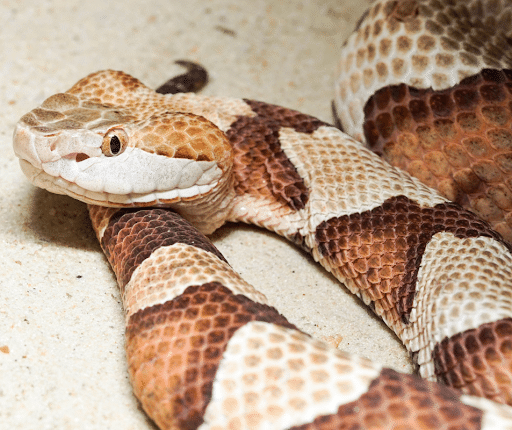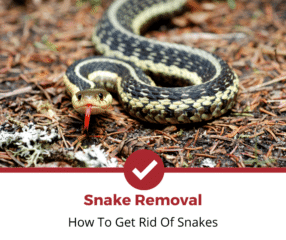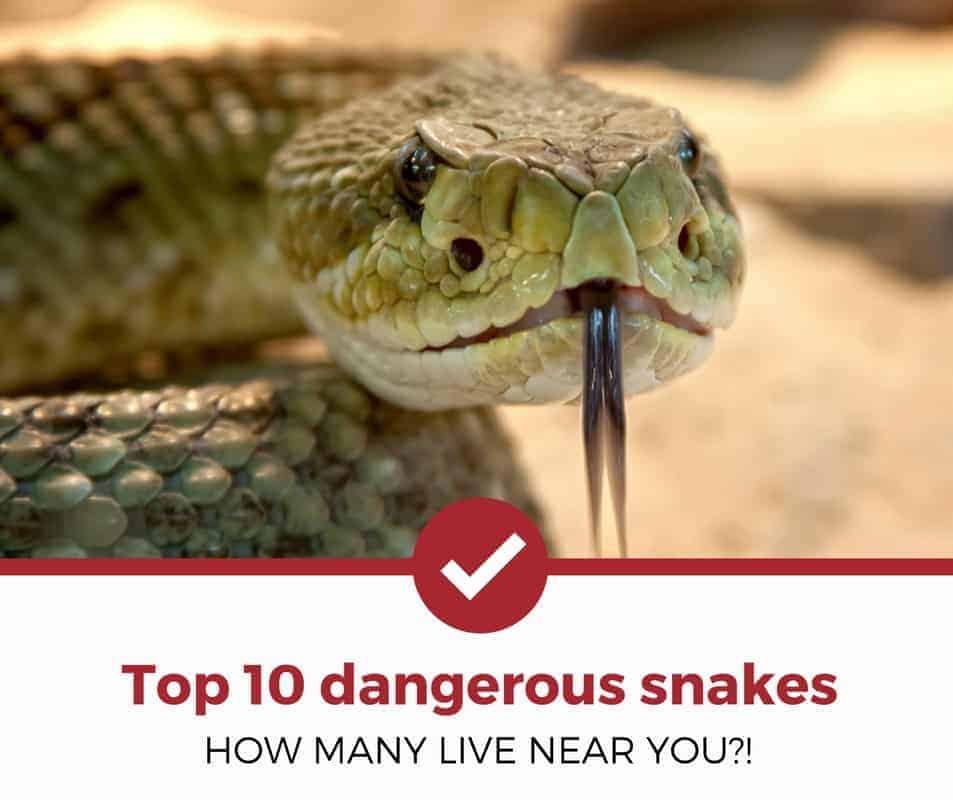Copperheads are in the same family as rattlesnakes. Although their venom is not as potent, they can still be dangerous. For that reason, it’s good to know the following:
- How to Quickly Remove Copperhead Snakes From Your Yard
- How To Deter Snakes From Your Property
- How To Tell the Difference Between Copperheads and Other Snakes
- 的症状和原因Snake Infestations
If trying to get rid of copperhead snakes on your own becomes too challenging, we recommendOrkin,Terminix, andAptive. These exterminators have some of the best-trained professionals that can use traps, baits, and other chemically treated solutions that are often more effective than standard DIY methods.
For Terminix quotes, you can reach them at 866-577-5051 or withthis form.
For quotes from Orkin, call 866-701-4556, or fill outthis form.
For a free quote from Aptive, call 855-521-7075 or visit the company’swebsite.

Ed has been working in the pest control industry for years helping 1,000's of homeowners navigate the world of insect and rodent management. He manages Pest Strategies now helping homeowners around the world!

Table of Contents
How To Get Rid of Copperhead Snakes
DIY homeowners confident enough to handle venomous snakes should still seek the advice of a professional. The following tips aremerely a starting pointfor snake safety and are not intended to replace certified instruction.
Inspection
The first place to look for snake activity is under porches, patios, and crawl spaces. These locations are worth clearing snakes from to avoid bites and other human interaction.
Other hiding places include:
- Yard refuse
- Under flat boards
- Firewood stacks
- Tall weeds and shrubs
- Old tires
Relocating Copperheads Safely
Once you identify the kind of snake you have, it’s time to relocate it. However, before starting, it’s always a good idea to check with your state’s wildlife regulations to determine safe release sites.
First, try waiting it out.
It may be worth it to see if the snake will move away on its own. For example, by removing plywood, mulch, and other harborages, it may seek cover elsewhere.
Spray It With a Hose
Another technique is to use a garden hose to gently encourage the snake to leave. By aiming a steady stream of water toward the animal, it may decide to move off. Just be sure to use low pressure to avoid injuring the snake.
Manual Removal
Follow these steps to remove a copperhead snake from your property:
Step 1:Gather your equipment. You will need the following:
- Five-gallon container with threaded lid
- Snake gaiters or chapsto protect against bites
- 39-inch snake hook
- Snake tongs with rubber jaws
- Two people, the handler and the assistant, ensure the handler’s safety and other people or animals that wander into the area. Never attempt snake relocation by yourself.
Step 2:Use a combination hook and tong method. Gently grasp the snake with the tongs about one-third distance from its head. While it is held in place, slide the hook under the snake to carefully support its body. This is an important detail since it avoids injuring the animal.
Step 3:Place it in the container. Place the snake into the container using one smooth, deliberate motion. Make sure it’s at the bottom of the bucket before releasing.
Step 4:Secure the lid. Immediately after the snake is placed in the container and the handler is clear, the assistant secures the lid while using it as a shield against the snake.
Step 5:Label the container. Label the container “Danger: Venomous Snake.” You should also note the date and time of capture.
Releasing the Snake
First, it’s beneficial to consult with your local animal control office while deciding where to release a copperhead snake. Most states do not have concrete regulations concerning wildlife relocation. However, some do.
Be careful while unscrewing the container lid. Do not put any part of your free hand over the edge where a snake can bite it since they often strike in an upward direction. Also, be sure to use the lid as a shield against bites.
Once the lid is off, tip the bucket over to release the snake. If it does not slither away immediately, give it a few minutes. Otherwise, lift the bucket from the back using a hook or a pair of tongs.
Snake Traps
Glue traps can sometimes work to catch a wayward snake. However, do not attempt to use mouse glue boards. They are much too flimsy for snake removal.
Instead, utilize onesdesigned for snakes or rats. They have a deeper adhesive base and will hold up well to most snake species. In addition, there are some available up to eight feet in length.

How to Keep Copperhead Snakes Away from Your Yard
Keeping snakes out of your yard takes an integrated approach. Here, our wildlife experts list the essentials of what that means.
Cut off Food Sources
Adult copperhead snakes eat mostly vertebrate animals, including:
- Frogs
- 鸟
- Squirrels
- Mice
- Rats
Young copperhead snakes, on the other hand, prefer invertebrates, such as:
- Cicadas
- Spiders
- Grasshoppers
- Beetles
- Millipedes
These are all common pests that most exterminators treat regularly. To limit the copperhead’s food source, it’s helpful to schedule regular pest control visits at least quarterly.
Limit Snake Harborage
The copperhead favors backyards with plenty of deciduous trees where the leaves fall in autumn. Leaf litter and mulch are perfect hiding spots for this ambush predator, so it’s best not to leave piles of it lying around.
Tall, grassy marshes are also suitable for cover. Yards with overgrown weeds, tall grass, and standing water are like a magnet to copperhead snakes. For that reason, it’s best to keep vegetation low and repair outdoor plumbing leaks.
In addition, it’s good to keep woodpiles stacked tightly and away from your house. That goes for lumber and other building materials as well.
Utilize Exclusion Methods
During the summer months, snakes tend to slither into crawl spaces to get cool. They also find their way under your house when it turns cold outside.
To close entrances to these areas, use tight wire mesh. Expansion foam works well to seal smaller openings.
Apply Snake Repellents
Natural snake repellentscome in a wide assortment of essential oil formulations, including:
- Cinnamon oil
- Peppermint oil
- Lemongrass
- Marigold
蛇驱虫剂,是否由自然或切mical ingredients, have little scientific backing to support their efficacy. Despite that, since product reviews are mostly positive, they are at least worth a try.
Mothballs, on the other hand, should never be employed as snake repellents since the EPA does not authorize them for off-label applications. Also, when misused, they can harm the environment.

Copperhead vs. Rattlesnakes
The most apparent difference between these two reptiles is that the rattlesnake has its characteristic tail to scare away predators. Its head is also shaped differently, resembling a diamond.
Find A Local Exterminator
How To Identify Copperhead Snakes
Copperheads are recognizable by their unique features. Still, it’s essential to review how they are different from other species.
Description
Copperheads are venomous snakes in the same family of pit vipers as rattlesnakes. The average adult is two to three feet long and has a pinkish tint with a distinctive copper-colored head.
It displays various crossbands on its scales, ranging from dark brown to red. It also has a unique hourglass shape to the color pattern on its back.
Copperhead vs. Cottonmouth
The cottonmouth, also called the water moccasin or water snake, is known for its telltale feature: thewhite interior of its mouth, which it shows when threatened.
The cottonmouth is large like the copperhead but has different scale colors. While the copperhead is naturally copper-colored, a cottonmouth has amuddy brown bodywith black or gray bands.
Some other noticeable differences include:
- Behavior:The cottonmouth is shy and prefers to spend its time hiding or swimming.
- Length:Copperhead snakes are from two to three feet long, while cottonmouths are slightly longer, ranging between two and four feet in length.
- Habitat:Cottonmouths are native to the Southeastern U.S. In contrast, the copperhead lives in the midwest and southern states, ranging only as far west as Texas.
Copperhead vs. Garden Snakes
Garden snake is another name given to the ubiquitous garter snake, which is found in almost every grassy location in the U.S. The main differences between this snake and the copperhead are:
- Size:Copperheads have thick bodies and grow two to three feet long, while garden snakes are slim and only one to two feet long.
- Color:The copperhead is mostly brown, while the garden snake can be gray, green, or black. Garden snakes have atrio of yellow stripeswhich run vertically down their bodies.
- Behavior:Garden snakes are shy and leave humans alone, similar to copperheads. However, they rarely bite and are nonvenomous.
Copperhead vs. Black Snakes
Black rat snakes live in the same regions of the U.S. as copperheads but grow much larger. Adults tend to be fromthree to five feet longand have thick bodies.
Unlike the copperhead, the black rat snake is usually all black and lives in swampy woodland areas. They typically avoid people but will become aggressive if cornered. In addition, they shake their tails to make asimilar sound to a rattlesnakein an attempt to scare away predators.
Copperhead vs. Rattlesnakes
The most apparent difference between these two reptiles is that the rattlesnake hasits characteristic tailto scare away predators. Its head is also shaped differently, resembling a diamond. However, some of the most notable distinctions between the rattlesnake and the copperhead are:
- Color:The copperhead is the color of a penny, sometimes displaying a pinkish hue. The rattlesnake is usually light brown or tan with darker brown diamonds on its sides and back.
- Habitat:The rattlesnakeprefers dry environmentswithin the arid regions of the U.S. You will most likely encounter one in a desert, dry land, or scrubland.
- Size:Rattlesnakes range in size from four to eight feet, making them some of the largest pit vipers in the U.S. Meanwhile, the copperhead is only two to three feet long at most.
Signs & Causes of a Copperhead Snake Infestation
Habitat
Leaf and mulch piles in the yard are ideal habitats for copperhead snakes. They also look for cover close to the ground, such as underneath flat boards.
Behavior
Copperheads are among the most common snakes in North America, ranging from Southern Florida to West Texas. They’re not aggressive unless they feel like they are being threatened.
While there are about 3,000 reported copperhead snake bites each year, they’re typically caused by people stepping on them by accident.
Diet
Adult copperheads are primarily carnivores, eating mostly vertebrate animals, such as:
- Lizards
- Frogs
- Mice
- Rats
- Other snakes
However, younger copperheads use their colorful tails to lure bugs and insects. Once they get close, the young snake will pounce and swallow their prey whole.
Last Word On Copperheads
摆脱你的蛇problem is no joke. It requires a bit of knowledge and planning to pull it off. Hopefully, we have given you a head start here.
Keep in mind that you’redealing with a venomous snakethat can cause you harm. For that reason, it makes sense to consult with a professional, even if only to ensure you are following local regulations.
Pest control and wildlife control companies are excellent places to start. They have technicians that are specially trained in wildlife control and management.



